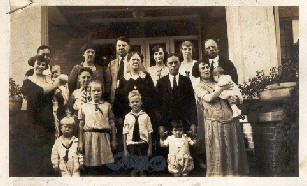
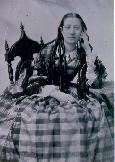
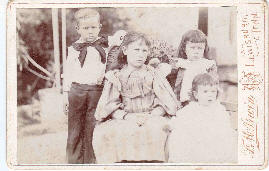
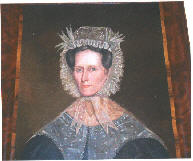
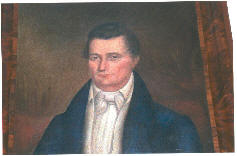



Manoah Bostick Hampton and Cynthia Mitchell Hampton
“Lilie” Hampton 4 oldest children of Lilie Hampton & Walter McClure Lilie Hampton McClure and her family, 1923
Robison Family, continued (page 5)
The Children of George Heyward Robison and Elizabeth Ann Stewart (continued)
The Children of George Heyward Robison and Elizabeth Ann Stewart (continued)
3) George Stewart Robison was born 1 Jan 1768 Barnwell District, SC, died 3 Sep 1853. He married Elizabeth “Betsy” Ann Robison, his first cousin, daughter of William Robison and Mary Lark.
The Barnwell People-Sentinel , Thursday, April 16, 1987:
"PORTRAIT OF EARLY BARNWELL RESIDENT FINDS WAY TO BARNWELL COUNTY MUSEUM….Museum Acquisition. [The] portrait of George Stewart Robison, one of Barnwell County's earliest residents, has been acquired by the Barnwell County Museum and is now on display there for viewing during museum hours. [photo of portrait in newspaper]. The Barnwell County Museum has recently acquired a portrait of one of Barnwell County's early residents, George Stewart Robison, of old Barnwell District, 1768-
"The portrait of George Stewart Robison by Prime has a well-
"Robison had settled with his wife on a beautiful elevated spot about two miles north of Little Hell Landing on the Savannah River, and there he commenced his married life, with some twenty slaves and numerous cattle, under the will of his father, George Robison. The diary of the subject's great grandson, Confederate Cavalry Colonel and Congressman from Georgia, GEORGE ROBISON BLACK, describes him thus:
(see text as written by George Robison Black (page 1)/ I will not repeat it here)
"Robison and his wife had six (6) children, only one of whom lived to marry. Their daughter, Betsey Robison, was born January 25, 1792, married William Kirkland about 1809, and died on February 2, 1812, after the birth of her firstborn, Augusta George Anna Kirkland.
"Besides planting, Robison, according this this great grandson, was the owner of saw mills whose saw timber was rafted to Savannah on the river, and also the operator of pole boats that transported goods between Augusta and Savannah. Thus Augusta George Anna Kirkland, was the only lineal descendant of her grandparents. She married on March 20, 1832, Edward J. Black, who became a Congressman from Georgia; they resided at his plantation, "Black Acre", in Screven County, Georgia. Mrs. Black died at the residence of her son, Charles Augustus Black, in Barnwell County, South Carolina, on June 26, 1880.
"From Augusta George Anna Kirkland Black, the portrait passed to her son Charles Augustus Black (who had married Lucy Dunbar), and from him to his daughter, Ann Eliza Black Walton. Mrs. Walton sold the portrait in 1935 for $75.00 to John Shaw Billings the husband of her cousin, Frederica Wade Billings, a great-
The only child of George Stewart Robison and Elizabeth Ann “Betsy” Robison to live & marry was:
Elizabeth “Betsy” (Augusta?) Robison. Betsy was born 25 Jan 1792, and died in childbirth on 2 Feb 1812 with the birth of her only child. She had married William Kirkland about 1809.
That left little Augusta Georgeanna Kirkland, born 2 February 1812, a newborn who had lost her mother. Raised by her grandparents, she married Edward Junius Rosario Black, on 20 Mar 1832. Edward was born 30 Oct 1805 Screven County, SC; died 1 Sep 1846Millettville, Allendale County, S.C. Her grandfather signed her marriage contract. Biographies are readily available about the Hon./Mr. Black. My notes have:
EDWARD JUNIUS BLACK was actively involved in the politics of Screven County, SC. As stated in "The History of Screven County, Georgia", chapter: "More Politics in Old Jacksonborough", the political parties met on September 7, 1835 to prepare resolutions protesting the activities of the abolitionists in the North. Edward Junius Black was the leader of the 'Nullifiers'. William W. Black was secretary of the group. The committee was equally divided between Jacksonian Democrats, or "Union" men, and the Nullifiers, or "States Rights" men. The committee returned four resolutions: 1) they condemned the "fanatics and abolitionists" who were "wantonly" pursuing a course that would lead to civil war; 2) stated that if the abolitionists "persist in their incendiary operations against the people of the South, we will look to ourselves for protection"; 3) called on the state legislature to protect the citizens of the State in the exercise of the "just constitutional rights," and 4) asserted that the legislature had the right to enact laws "relative to the publication and circulation of Abolitionist pamphlets and other incendiary writings." From all accounts, the discussions were extremely heated. The "Union" leader, Captain William Hotchkiss, after a spirited uproar, was allowed to read from an abolitionist document, "The Emancipator", and stated that "though there was no law permitting abolition in the Southern states, it was indeed legal for Congress to abolish slavery in the District of Columbia".
"Then arose Edward Junius BLACK. He was a fire-
Chapter: "Screven County's First Congressman" "EDWARD JUNIUS BLACK was born in Beaufort District, South Carolina, on October 30, 1805. His father was William Black (1774-
"Edward J. Black's father lost a considerable part of his wealth through an unfortunate security-
" E. J. Black was elected to the state legislature from Richmond County (GA) in 1829.
" In 1831 he was the Whig candidate for Attorney General of Georgia, losing by a narrow margin to Charles J. Jenkins.
" Was elected as a Whig to the U. S. House of Representatives in 1839, but later denounced the party as not being "sufficiently dedicated to the cause of the Southern planter."
" In March, 1842, he was elected as a Democrat to fill a vacancy
" And in March 1845, he was elected to serve another full term in the House.
E. J. Black died September 1, 1849, at the home of his wife's grandfather, GEORGE ROBISON, in Barnwell District. His children as listed in his will were: Elizabeth Hanson Black, George Robison Black, Edward Junius Black (Jr.), Charles Augustus Black, and William Raymond Black.
Georgianna Kirkland and Edward Junius Black had the following children:
A) Edward Junius (Jr) BLACK (b.23 Feb 1832 d.12 Jul 1871)
| sp: Mary Alice DUNBAR (b.5 Jul 1842 d.16 Aug 1905)
B) George Robison BLACK (b.24 Mar 1835-
| sp: Georgia Ann Elizabeth BRYAN (m.14 May 1863)
| sp: Mary Ellen "Nellie" PETERS (b.1851-
C) William Raymond BLACK (b.26 Jan 1837 d.25 Apr 1857)
D) Elizabeth Hanson BLACK (b.Eufaula,AL)
| sp: Paul Delacy BAKER
E) Thomas Jefferson BLACK (b.15 Jul 1841 d.1880)
| sp: Belle BOWIE
F) Charles Augustus BLACK (b.4 Nov 1843)
| sp: Lucy Minor DUNBAR (b.1844 d.20 Oct 1908-
G) Robert Reid BLACK (b.6 Jun 1846 d.14 Oct 1847)
----------------------------------------------------------------------------
4) Ann Robison. I’m thankful to Bruce Odom for providing the following notes about Ann. I haven’t spoken with Bruce in awhile, and I have not researched Ann any further.
4) Ann Robison. I’m thankful to Bruce Odom for providing the following notes about Ann. I haven’t spoken with Bruce in awhile, and I have not researched Ann any further.
Ann married (1) (Mr.) SQUIRE.
They had the following children:
2 F i. Betsey Robison SQUIRE.
Ann also married (2) George ODOM.
1 [1] Ann Robison
. +??? Squier
*2nd Husband of [1] Ann Robison:
. +George Odom - 1839
........ 2 [2] Sarah Robison Odom 1800 -
............ +Henry M. Peeples 1797 - 1824
........ *2nd Husband of [2] Sarah Robison Odom:
............ +John W. Matheny 1803 - 1862
........ 2 [3] Lucy Dunbar Odom
............ +Darling Pinckney Peeples 1802 - 1829
........ *2nd Husband of [3] Lucy Dunbar Odom:
............ +William M. Jones
........ 2 George Robison Odom 1805 -
............ +Rosanna 1807 -
........ 2 Allen Madison Odom
............ +Eliza Hagood
. +??? Squier
*2nd Husband of [1] Ann Robison:
. +George Odom -
........ 2 [2] Sarah Robison Odom 1800 -
............ +Henry M. Peeples 1797 -
........ *2nd Husband of [2] Sarah Robison Odom:
............ +John W. Matheny 1803 -
........ 2 [3] Lucy Dunbar Odom
............ +Darling Pinckney Peeples 1802 -
........ *2nd Husband of [3] Lucy Dunbar Odom:
............ +William M. Jones
........ 2 George Robison Odom 1805 -
............ +Rosanna 1807 -
........ 2 Allen Madison Odom
............ +Eliza Hagood
5) Louisa Robison married 1) Daniel Govan; married 2nd.) John Chevilette. I do have a few notes about her descendants (see pdf file).
6) Sarah Robison (no information)